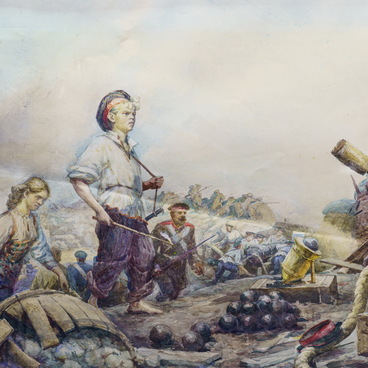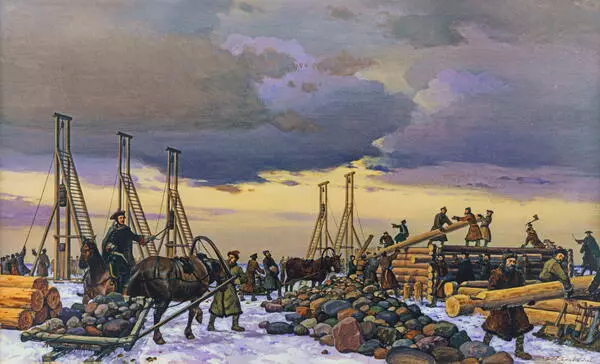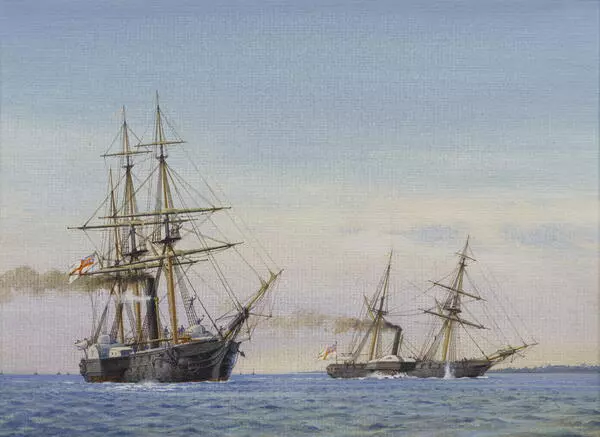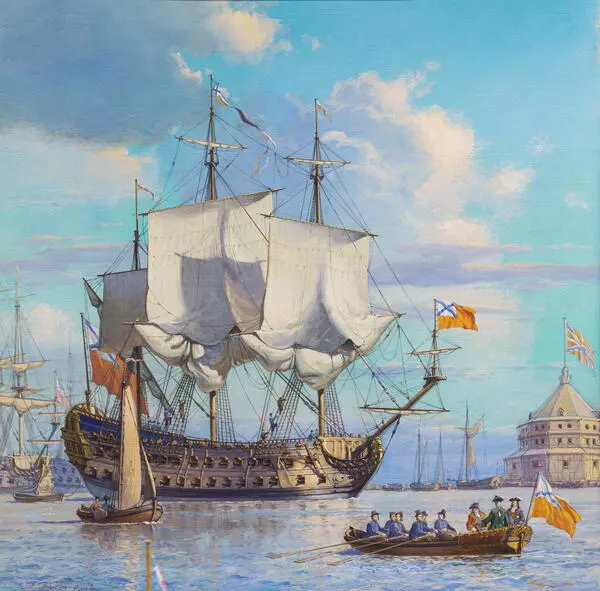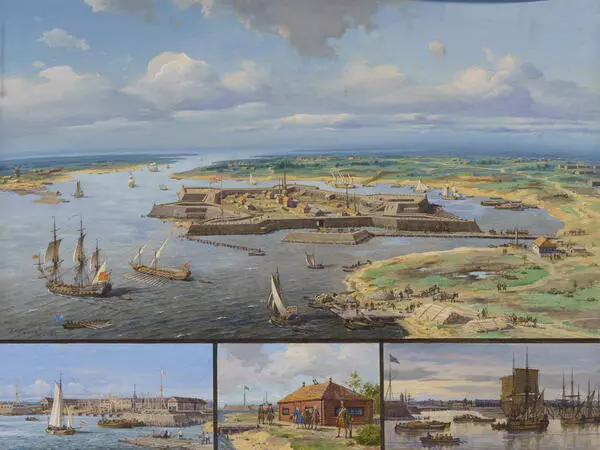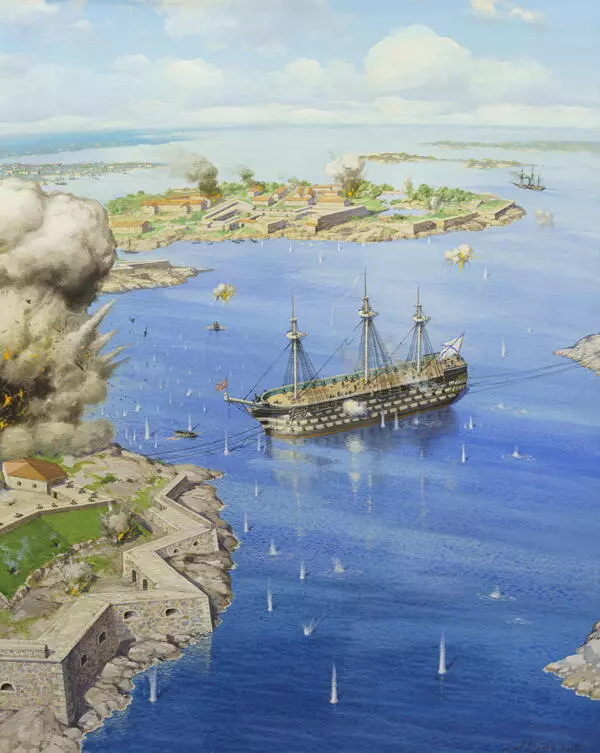“Saint Evstafi Plakida” was a 66-gun ship that took part in the Russo-Turkish War of 1768–1774. In July 1769, she left Kronstadt leading the First Archipelago Squadron under the flag of Admiral Grigory Andreyevich Spiridov. In the second half of May 1770, when the First and Second Archipelago Squadrons met at the island of Kythira, the fleet entered the Aegean Sea to look for Turkish ships. Russian scout ships discovered them in the strait between the tip of Anatolia and the island of Chios. On the night of June 23 to 24, 1770, Russian commanders held a military council and approved the plan of attacking the Turkish fleet.
On the morning of June 24, the Russian fleet started approaching the enemy. The “Evropa” ship was the leader, going almost into the midst of the enemy’s line. Following closely behind “Evropa” was “Saint Evstafi Plakida”. When “Evropa” approached enemy ships, the Turks started firing, while the Russian ship kept getting closer. Finally, at a distance of 50–70 meters, “Evropa” fired all of its guns. Due to navigation hazards, “Evropa” went out of service and was replaced by “Evstafi”. She focused on firing at the Turkish flagship named “Real Mustafa” from a distance of 50 meters.
Admiral Spiridov, wearing his full dress uniform and having drawn his sword, stood in the rear section of the open deck. The musicians were asked “to play until the very end”. Two battling ships came alongside each other. The ropes, masts, and spars were destroyed, the sails damaged, and many members of the crews were wounded and killed, while the survivors continued firing at each other with pistols and guns. At 1 pm, the cannon shots of “Evstafi” set “Real Mustafa” on fire. Russian sailors ran onto the board of the enemy ship, and reckless hand-to-hand fighting began. The main mast of “Real Mustafa” was engulfed in flames. It came down and landed across the “Evstafi” ship’s deck, with sparks showering into the open powder magazine full of ammunition. “Evstafi” exploded, and “Real Mustafa” blew up shortly thereafter. Having realized that his ship was already past saving, Admiral Spiridov followed the instructions of the Navy Regulations and boarded a boat together with Count Fyodor Orlov shortly before the explosion. 620 crew members, including 22 officers, died on the Russian ship. “Real Mustafa” also exploded after catching on fire. Turkish ships, trying to escape fire and the attacks of Russian artillery, found shelter in Çeşme Bay. The Russians pursued them up to the entrance. The battle lasted around two hours. Two days later, the Turkish fleet was destroyed in Çeşme Bay.
In 1899, Russian divers explored the area where “Evstafi” had sunk, and some of the discovered objects were donated to the Naval Museum in Saint Petersburg where they are still demonstrated nowadays in one of the cases of Hall No. 1.
On the morning of June 24, the Russian fleet started approaching the enemy. The “Evropa” ship was the leader, going almost into the midst of the enemy’s line. Following closely behind “Evropa” was “Saint Evstafi Plakida”. When “Evropa” approached enemy ships, the Turks started firing, while the Russian ship kept getting closer. Finally, at a distance of 50–70 meters, “Evropa” fired all of its guns. Due to navigation hazards, “Evropa” went out of service and was replaced by “Evstafi”. She focused on firing at the Turkish flagship named “Real Mustafa” from a distance of 50 meters.
Admiral Spiridov, wearing his full dress uniform and having drawn his sword, stood in the rear section of the open deck. The musicians were asked “to play until the very end”. Two battling ships came alongside each other. The ropes, masts, and spars were destroyed, the sails damaged, and many members of the crews were wounded and killed, while the survivors continued firing at each other with pistols and guns. At 1 pm, the cannon shots of “Evstafi” set “Real Mustafa” on fire. Russian sailors ran onto the board of the enemy ship, and reckless hand-to-hand fighting began. The main mast of “Real Mustafa” was engulfed in flames. It came down and landed across the “Evstafi” ship’s deck, with sparks showering into the open powder magazine full of ammunition. “Evstafi” exploded, and “Real Mustafa” blew up shortly thereafter. Having realized that his ship was already past saving, Admiral Spiridov followed the instructions of the Navy Regulations and boarded a boat together with Count Fyodor Orlov shortly before the explosion. 620 crew members, including 22 officers, died on the Russian ship. “Real Mustafa” also exploded after catching on fire. Turkish ships, trying to escape fire and the attacks of Russian artillery, found shelter in Çeşme Bay. The Russians pursued them up to the entrance. The battle lasted around two hours. Two days later, the Turkish fleet was destroyed in Çeşme Bay.
In 1899, Russian divers explored the area where “Evstafi” had sunk, and some of the discovered objects were donated to the Naval Museum in Saint Petersburg where they are still demonstrated nowadays in one of the cases of Hall No. 1.



